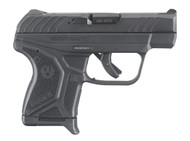Good Write Up On The Ruger LCP II
Posted by Abide Armory on 12th Jun 2019
Nice little write about the Ruger LCP II. By Alex Joseph of gunnewsdaily.com
CLICK HERE to Check Out Our Entire Inventory of LCP II's!
THE #1 BEST .380 POCKET ROCKET: RUGER LCP II
The .380 ACP semi-automatic pistol is one of the most popular categories of concealed carry weapons in the United States and has been for years.
It’s easy to see why: .380 pistol are typically small enough to carry in the pocket, they are unquestionably smaller and lighter than competing 9mm single stack autos or .38 snubnose revolvers.
But despite those advantages, .380 pocket pistols have also been plagued by a number of downsides. The Ruger LCP II, released by Ruger at the end of 2016, sought to remedy many of those downsides.
In this review, we will cover the disadvantages of the .380 pistol that the LCP II sought to remedy, what makes the LCP II an improvement over the original LCP, and the uses for and specifications of the LCP II.
WHAT ARE THE DISADVANTAGES OF THE .380 POCKET PISTOL?
.380 pocket pistols are incredibly easy to conceal, and this is what is largely attributed to their long time popularity in the United States.
Examples of popular small pocket .380 autos include the original Ruger LCP, Taurus TCP, Smith & Wesson Bodyguard .380, and the Kel-Tec P3-AT to name a few. Every one of these pistols are incredibly easy to conceal in your pocket.
Unfortunately, each of these pistols and others in their class suffer from a number of serious flaws.
These flaws include, but are not limited to:
THEY HAVE TERRIBLE TRIGGER PULLS
.380 pocket pistols have a well-deserved reputation for having some of the worst trigger pulls of any semi-automatic pistols on the market.
The trigger pull on most .380 autos is exceptionally long and gritty. In other words, it’s not pleasant to shot at all.
While larger .380 pistols such as the Walther PPK/S, Walther PK380, Bersa Thunder 380, and Glock 42 don’t have this problem, the truly small pocket pistols such as the LCP and TCP most certainly do.
THEY’RE DIFFICULT TO SHOOT
.380 pocket pistols are traditionally difficult to fire for a number of reasons: in addition to the horrid trigger pulls like we just discussed, they also suffer from being extremely snappy due to their small size.
Granted, .380 pocket autos are not guns that you take to the range for fun. They are meant to be defensive arms that can be easily carried in the pocket. Nonetheless, the fact that they are difficult to shoot can be a major problem for training and self-defense purposes.
THEY HAVE POOR ERGONOMICS
Last but not least, and while this is entirely personal preference, many regard .380 autos as having poor ergonomics due to the fact that their extraordinarily small size means you can’t get a full grip on them. This only naturally makes it more difficult to fire properly like we just talked about.
Ruger sought out to remedy much of these problems with the LCP II. Did they succeed? Let’s find out by comparing it to the original LCP.
BATTLE OF THE RUGER .380S: LCP VS. LCP II
The original Ruger LCP has been perhaps the most well-known and popular .380 pocket pistol since it was first introduced in 2008. Nonetheless, it still suffers from many of the issues that we just talked about in the previous section: the trigger pull is awful, they are difficult to shoot, it can be difficult to get a good grip on the pistol for some shooters, and the slide won’t even lock back on the last round fired.
Ruger listened to the criticism, which resulted in the birth of the LCP II. While the LCP II is still a small pocket pistol, Ruger made a number of improvements to it.
The biggest improvement, by far, is the trigger pull. The trigger pull on the LCP II most closely resembles the trigger on larger striker fired polymer pistols such as the Glock. It is considerably lighter and smoother than the original LCP and other comparable .380 pistols, and it also features the Glock-style bladed safety that must first be depressed in order for the trigger to be pulled.
Overall, the trigger on the LCP II makes it infinitely easier to shoot than the original LCP. Ruger markets the trigger as having a six pound pull. The reason the trigger pull is lighter is because it is a SA trigger versus the DA trigger on the original LCP.
The LCP II also features forward and rear serrations on the slide, whereas the original LCP only featured serrations on the rear. The serrations on the LCP are also wider in order to get a better grip in slippery conditions when racking the slide.
The trigger guard on the LCP has also been enlarged in order to accommodate a gloved finger without risking pulling the trigger.
The grip is also slightly enlarged in order to get a better grip, with an improved stippling job as well to better accommodate wet or slippery conditions.
All of these features together, the improved trigger, the enhanced serrations, the stippling on the grip, and the slightly wider grip size all combine to make the LCP II a better handgun to shoot than the original LCP.
Yes, the LCP II is still a .380 pocket pistol and as a result is still snappy. It’s not a range gun, and should not be treated as such.
Yet one more advantage for the LCP II is the fact that the slide locks back on the final round fired to signal you are empty. When you insert a fresh magazine, it will be easier to rack the slide this way as well. In contrast to this, the original LCP did not lock back on the final round.
While the LCP II will accept the same 6 round magazines as the original LCP, it also will not slide lock on the last round with those magazines because they were not designed to do so. Therefore, if you want the slide to lock back, you need to use the magazines that were made specifically for the LCP II.
One thing that was not improved over the original LCP, however, is the sights. The sights on the LCP II are built into the top of the slide like its predecessor. Both the front and rear sights are black which can make it difficult to see them if you are aiming against a dark background.
USES FOR THE RUGER LCP II
There are two primary uses for the LCP II: concealed carry and/or as a back-up pistol.
Ruger sells the LCP II with a neoprene pocket holster (which has the Ruger logo on it), and it actually works quite well. It covers the trigger guard of the pistol and has a hook and sticky material to stay secure in your pocket so it is easy to draw the pistol from your pocket without bringing the holster with it.
That being said, the LCP II can also be carried IWB or in an ankle holster just as easily as it could be carried in a pocket. But if carry options are limited to just a pocket carry for you (i.e. you have to wear shorts with a tucked in shirt), the LCP II will be a great option.
As a back-up weapon to a larger pistol, the LCP II would also be a great choice as it has a very similar manual of arms to larger pistols such as Glocks while also being small enough to easily conceal carry as we have just seen.
LCP II SPECIFICATIONS
Here are some basic facts for the Ruger LCP II:
Caliber: .380 ACP
Capacity: 6+1
Weight: 10.6 ounces
Length: 5.17 inches
Width: .91 inches
Frame: Glass Filled Nylon
Barrel Length: 2.75 Inches
Barrel Material: Alloy Steel
Trigger Pull: 6 pounds
Sights: Integral
Finish: Blued
CONCLUSION
In conclusion, the Ruger LCP II simply represents the beginning of the evolution of the .380 pocket pistol. Ruger has proven that you don’t need to have an arduous and gritty trigger pull on a .380 auto and it’s likely that more manufacturers will now follow their lead.
With a much lighter trigger, enhanced slide serrations, wider grip, impressive stippling job, and the ability to slide lock on the last round, the LCP II is a definitive improvement over other comparable .380 pocket guns.







